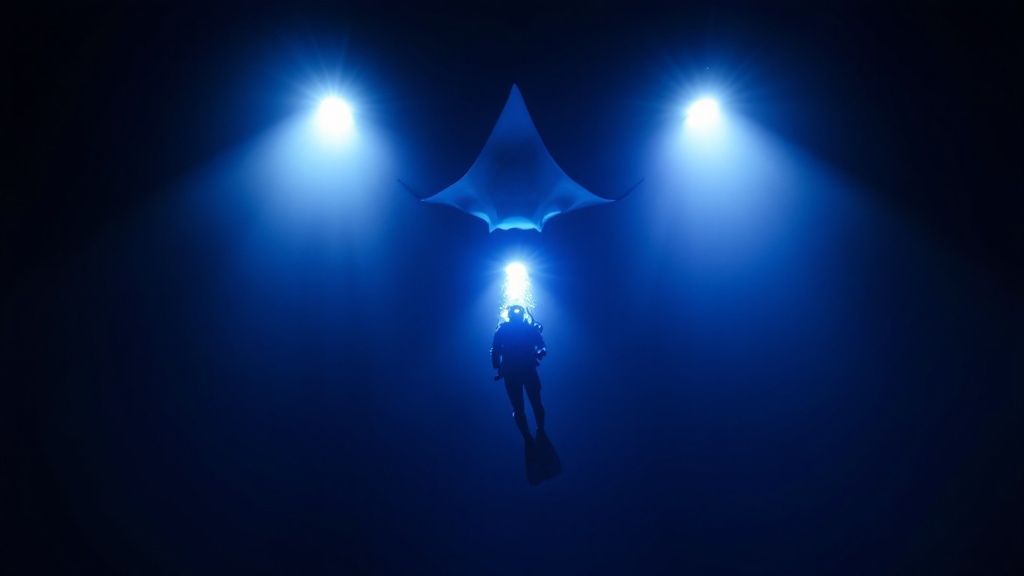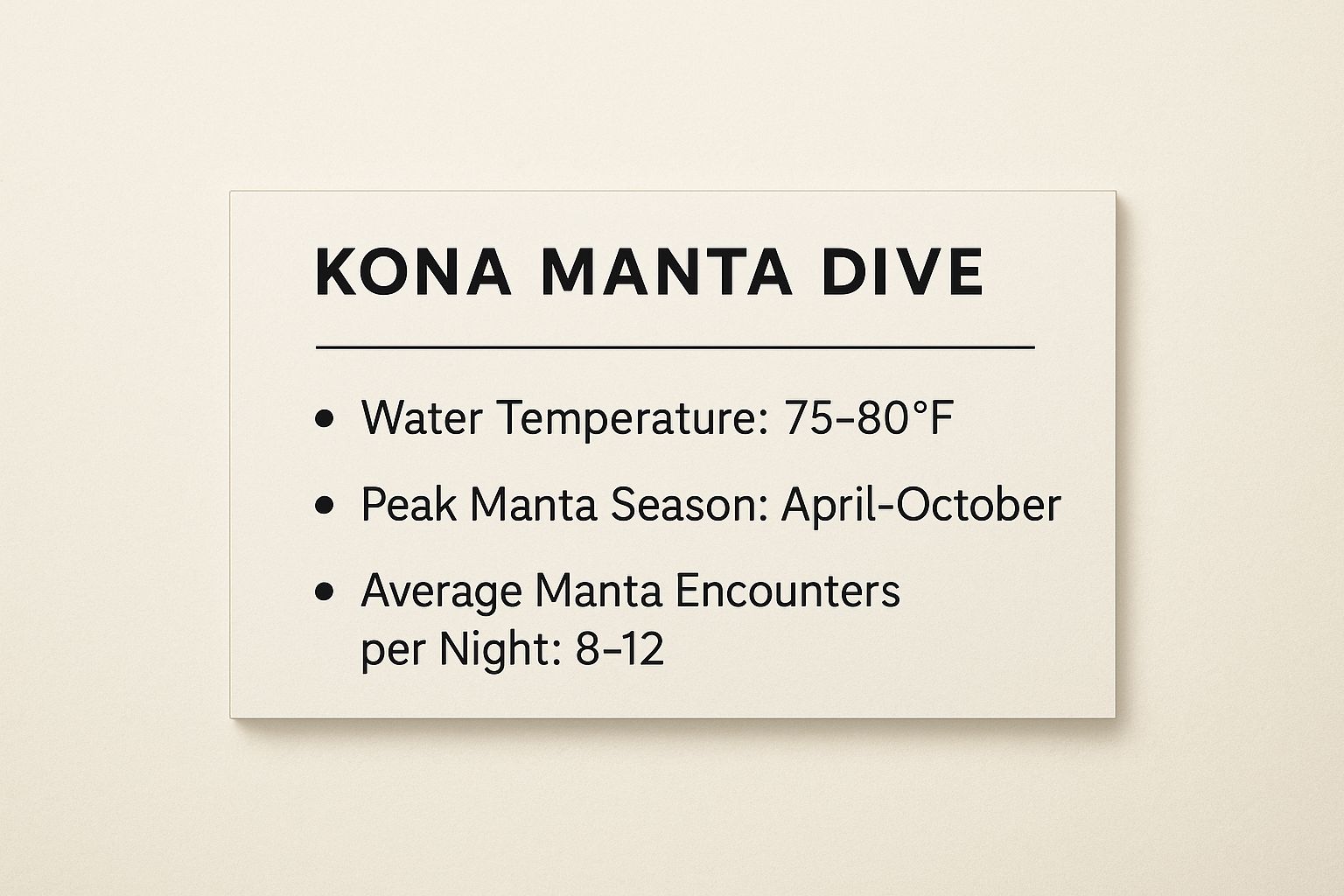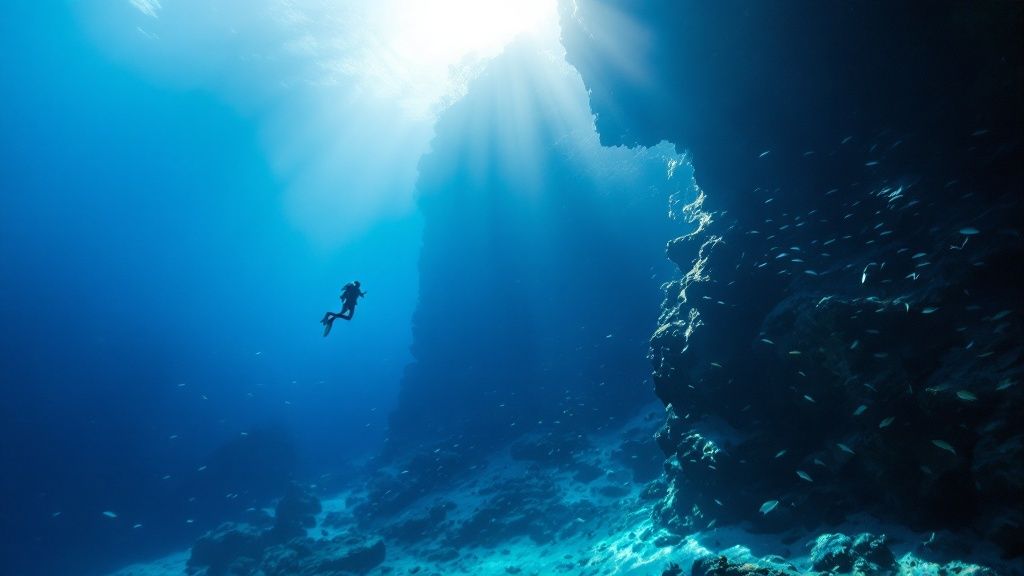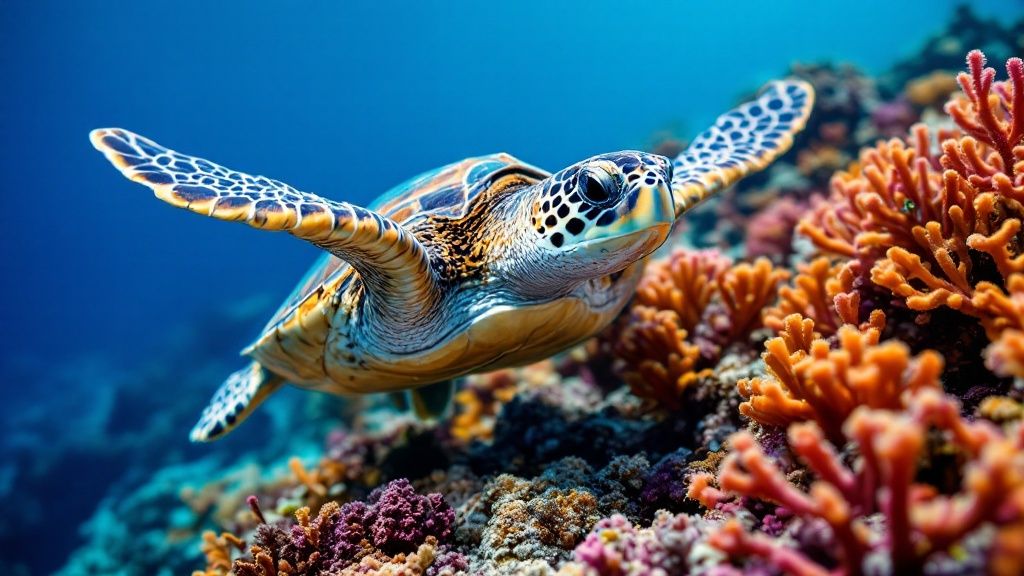Why Manta Dive Kona Creates Unforgettable Memories
The magic of a manta ray dive in Kona isn't just about ticking a box on your bucket list; it's a genuinely profound experience. Unlike typical tourist attractions, this underwater encounter resonates deeply with ocean lovers worldwide, placing Kona firmly at the top of their must-visit destinations. There's a good reason for this. This specific coastline is a consistent gathering spot for these gentle giants due to a unique blend of natural circumstances.
Ocean currents deliver a plentiful supply of plankton, their main food source, while sheltered areas offer protection and a safe haven. This combination creates a truly exceptional environment.
The Perfect Underwater Sanctuary
Kona's blend of warm, clear waters and successful conservation efforts has created an incredible underwater sanctuary. Through ongoing research and discussions with marine biologists and experienced divers, we understand better why Kona attracts so many manta rays. These experts reveal the complex interplay between the environment and these graceful creatures, highlighting the positive impact of human efforts on a fragile ecosystem.
The consistent visibility in Kona's waters also provides outstanding viewing opportunities, increasing the likelihood of a truly memorable encounter. This makes the Kona coast an ideal spot for both seasoned divers and those experiencing a manta ray dive for the first time.
Unforgettable Encounters with Gentle Giants
Each year, approximately 80,000 people take part in manta ray snorkel and dive tours along the Kona Coast of Hawaii, making it a leading global destination for these excursions. The Kona area presents a special opportunity thanks to the reliable presence of manta rays. Some dive operators report sighting rates between 85% and 90% on night dives. The manta rays commonly sighted here have wingspans often exceeding 12 feet, making for remarkable underwater experiences. Find more detailed statistics here.
The sheer size and elegant movements of these creatures evoke a sense of awe and wonder, leaving a lasting impression. The experience is frequently described as emotionally moving, forging a deep personal connection between divers and the ocean. You might also be interested in: What It's Like to Go on the Manta Ray Dive in Kona, Hawaii.
Respecting the Marine Environment
When considering the environmental effects of manta diving, it's important to understand how to prevent marine pollution. Responsible tourism is crucial to safeguard this delicate ecosystem for future generations. This means choosing tour operators who prioritize sustainable practices and follow strict guidelines for interactions with manta rays.
Selecting a responsible tour operator is essential to minimizing the impact of human activity on these majestic creatures and their habitat. This guarantees the manta dive experience remains a source of wonder and inspiration for years to come. For those keen to explore Kona's underwater world, checking out our Manta Ray night dive in Big Island will provide valuable insights. This way, visitors actively contribute to the long-term health and well-being of this exceptional underwater realm.

Insider's Guide to Kona's Legendary Manta Sites
Not all manta ray dive sites are created equal. Kona, Hawaii, is renowned worldwide for its exceptional manta ray viewing opportunities. Two locations, in particular, stand out: Manta Village and Manta Heaven. Each site offers a unique experience, appealing to divers of different skill levels and interests.
Manta Village: The Original Manta Ballet
South of Kona, nestled in the calm waters of Keauhou Bay, lies Manta Village. This site holds a special distinction: it's the original manta ray night dive location. The shallow, sandy bottom and typically tranquil conditions create an ideal environment for divers of all experience levels, particularly beginners. It's here that the mesmerizing "manta ballet" unfolds. Multiple mantas often congregate, gracefully gliding through the water as they feed on plankton attracted by the dive lights. Learn more about Kona's manta dive sites.
Manta Heaven: Up Close and Personal
Further north, off the coast of Kona International Airport, you'll find Manta Heaven. The ocean floor here is a bit deeper than at Manta Village, and the currents can be slightly more active. This site offers the potential for incredibly close manta ray interactions, making it a thrilling choice for more seasoned divers. The unique underwater topography also provides captivating angles, especially appealing to underwater photographers.

The infographic above highlights some key planning information for your manta ray diving adventure in Kona. It details the water temperature, the peak season for manta encounters, and the average number of mantas you can expect to see. As shown, the ideal time to visit is between April and October when the water temperature is a comfortable 75–80°F, and sightings average 8–12 mantas per night dive.
Choosing the Right Site For You
Whether you choose Manta Village or Manta Heaven depends on your preferences and experience level. Manta Village is an excellent option for beginners or those seeking a relaxed dive with a high probability of seeing multiple mantas. Experienced divers seeking closer encounters and unique photographic opportunities may prefer Manta Heaven. You might also be interested in what the best time of year to see manta rays in Kona is. Both sites offer a unique and unforgettable experience, showcasing the elegance of these magnificent creatures.
To help you decide, let's take a closer look at the key differences between these two dive sites:
To help you choose the perfect site, here’s a comparison of Manta Village and Manta Heaven:
| Feature | Manta Village | Manta Heaven |
|---|---|---|
| Location | Keauhou Bay (South Kona) | Off Kona International Airport (North Kona) |
| Depth | Shallow | Deeper |
| Currents | Typically Calm | Can be more dynamic |
| Experience Level | Beginner-friendly | More suited to experienced divers |
| Manta Interactions | Multiple manta sightings, "manta ballet" | Potential for closer encounters |
| Photography | Good | Excellent, unique angles |
As you can see, each site offers its own distinct advantages. Consider your comfort level in the water, your desire for close interactions, and your photography goals when making your decision.
Lunar Cycles and Seasonal Variations
The lunar cycle significantly influences plankton abundance, which, in turn, affects manta ray activity. Divers often report increased manta ray sightings during brighter moon phases, as the increased light enhances plankton visibility for the mantas. While mantas can be seen year-round, the peak manta season in Kona is from April to October. During these months, calmer water conditions typically prevail, resulting in improved visibility and higher chances of multiple manta encounters. Understanding these seasonal and lunar factors can help you plan your manta dive trip for optimal viewing. Whether you choose Manta Village or Manta Heaven, a little pre-dive planning can significantly enhance your experience.
Planning Your Perfect Manta Dive Kona Adventure
Planning a manta dive in Kona, Hawaii, requires more than just picking a date and time. A little preparation can greatly enhance your overall experience. This involves considering several factors, from certification requirements and equipment choices to selecting a reputable tour operator and understanding the seasonal behavior of manta rays.
Choosing the Right Dive Operator
Selecting the right dive operator is paramount for a successful manta dive experience. Ask prospective companies about their safety procedures, experience, and commitment to conservation. Inquire about group sizes, guide qualifications, and adherence to responsible manta ray interaction guidelines. For more information on manta ray dives, check out this article about the Manta Ray Night Dive in the Big Island. Avoid operators who seem to prioritize profit over safety or animal welfare, or those with consistently poor reviews.
Understanding Seasonal Patterns and Water Conditions
Kona's manta rays are present throughout the year, but certain times offer distinct benefits. Peak manta ray season typically runs from April to October, offering calmer waters and better visibility. However, other months can offer unique encounters, like observing feeding behaviors or encountering fewer divers. For a different perspective on Kona's marine life, consider combining your manta dive with a snorkeling trip; check out this guide on Captain Cook Snorkeling Kona Hawaii. Understanding how water conditions impact visibility is essential for planning your dive, especially if underwater photography is a primary goal.

Equipment and Certification
Most operators provide basic equipment, but having your own comfortable wetsuit, mask, and snorkel can improve your dive experience. Ensure your dive certification is current and suitable for the specific dive site. Some locations might require advanced certifications due to depth or current conditions. This is especially important if you plan to dive at Manta Heaven, a spot known for its slightly deeper waters and active currents.
Pricing and Packages
Dive packages vary in cost and what they include. Compare prices from different operators, and pay close attention to what each package includes. A good package should include all necessary dive gear, a comprehensive pre-dive briefing, and experienced guides who prioritize your safety and a memorable manta ray encounter. Be wary of unusually cheap options, which could indicate compromised safety or quality. Choose operators with clear pricing and detailed package descriptions, including boat size, the number of dives, and any extra features.
Maximizing Your Manta Ray Encounter
Consider the smaller details that can elevate your manta ray experience. Experienced guides can offer insights into manta ray behavior, prime viewing spots, and underwater photography techniques in low-light conditions. They can also advise on proper dive etiquette and minimizing your environmental impact. These seemingly small details can significantly improve your dive. Respectful observation is vital for preserving this unique experience for everyone. Careful preparation and choosing a responsible operator contribute to a remarkable underwater adventure that respects these amazing creatures and creates an unforgettable experience in Kona's waters.
The Fascinating Science Behind Kona's Manta Magic
The effortless grace of manta rays gliding through Kona's dark waters feels almost magical. But this captivating display is a result of biological and ecological factors worth exploring before your manta ray dive in Kona. Understanding the science behind these encounters transforms simple observation into profound appreciation for these intelligent creatures.
The Science of the Feast
Manta rays are filter feeders, consuming tiny zooplankton. Their feeding strategy involves graceful barrel rolls and sweeping movements, maximizing plankton intake. This elegant "ballet" isn't just for show; it's a highly efficient way to gather food from nutrient-rich waters. The abundance of plankton in Kona, brought in by ocean currents, is a key reason why these gentle giants gather here.
Social Dynamics and Navigation
Manta rays aren't solitary. They exhibit complex social dynamics, often gathering in groups at predictable feeding spots. Their impressive navigational abilities, likely using magnetic fields and celestial cues, allow them to return to these sites reliably. This predictability makes manta ray dives in Kona so consistent and rewarding.
Tracking and Protecting Gentle Giants
Marine researchers use sophisticated methods to identify individual manta rays, often based on unique spot patterns on their undersides. This allows long-term tracking and monitoring, providing valuable insights into their life history, migration, and population dynamics. The history of manta ray sighting statistics along the Kona Coast spans over a decade, with detailed data collected annually since at least 2009.
To illustrate the value of data collection, in 2013, extensive records compiled by professional divers and marine advocates revealed "the total number of individual manta rays seen during night dives per month." This data, collected through video footage and direct observations, helped identify individual manta rays and understand population dynamics. Find more detailed statistics here.
Let's take a closer look at some of this data:
To better understand the impact of these findings, let's examine some key statistics:
The following table presents an overview of manta ray population data in Kona.
| Data Point | Statistics | Conservation Implications |
|---|---|---|
| Identified Individuals | Over 280 | Demonstrates a healthy, thriving population in the Kona region |
| Average Sightings per Dive | Varies seasonally, but often multiple individuals per dive | High sighting frequency indicates Kona's importance as a manta ray habitat |
| Population Growth | Relatively stable | Suggests successful conservation efforts and sustainable tourism practices |
This data highlights the importance of Kona as a habitat for manta rays and underscores the need for continued research and conservation.
Citizen Science and Conservation
You can contribute to research by participating in citizen science initiatives during your manta ray dive. Many dive operators encourage guests to submit photos and videos of manta rays, helping expand the database of identified individuals. Your dive directly supports conservation, as proceeds often fund research and protection programs. These initiatives are crucial for the long-term survival of these magnificent creatures and the health of the marine environment.
By understanding the biological and ecological factors that bring manta rays to Kona, your underwater encounter becomes more than a thrilling experience. It's a connection to a remarkable evolutionary story. This knowledge allows you to appreciate the beauty, intelligence, and fragility of these ocean giants, inspiring a deeper commitment to their protection.
The Manta Dive Experience: From Briefing to Breathtaking

Imagine the thrill of pulling on a wetsuit, the anticipation bubbling as you prepare for a manta ray dive in Kona. This guide walks you through every step of the journey, from the initial preparations on shore to that breathtaking moment when a giant manta glides gracefully above you.
Preparing for the Dive: The Briefing
Your adventure begins with a thorough briefing. Your dive guide will walk you through essential safety procedures. This includes vital hand signals, emergency protocols, and, importantly, the proper way to interact with the majestic manta rays. This is your opportunity to ask questions, voice any concerns, and ensure you feel completely comfortable before entering the water.
Entering the Water and Finding Your Position
Once you arrive at the dive site – perhaps the renowned Manta Village or Manta Heaven – you'll enter the water and descend to the ocean floor. Divers typically arrange themselves in a semi-circle around the dive lights. These lights are strategically positioned upwards, attracting plankton. Maintaining neutral buoyancy is crucial. It allows you to remain comfortably in place without disturbing the sandy bottom or the surrounding marine life. This involves carefully controlling the air in your BCD (buoyancy control device).
The Manta Ballet Begins
As the plankton accumulates in the illuminated water, the stars of the show arrive: the manta rays. Their movements, graceful and fluid, resemble a mesmerizing underwater ballet. These gentle giants, with wingspans often exceeding 12 feet, navigate the water with effortless elegance, performing barrel rolls and loops as they feast on the plankton. Remember the golden rule: no touching or chasing the mantas. Simply observe and appreciate these incredible creatures in their natural habitat. You may also be interested in learning more about diving in Hawaii: Why You Should Consider Scuba Diving Hawaii.
Photographing the Gentle Giants: Tips for Low-Light Conditions
Capturing the magic of a manta ray dive in Kona presents a unique photographic challenge due to the low-light environment. Preparing your camera settings in advance is essential. A combination of high ISO, wide aperture, and slow shutter speed is often recommended. A red filter can also help to correct the color balance in your photographs. Patience is your greatest asset. Anticipate the manta rays’ movements and be ready to capture that perfect shot.
Respectful Observation: Ensuring a Positive Experience
Manta rays are sensitive creatures. Respectful observation is paramount for both their well-being and the enjoyment of all divers. Maintaining a respectful distance, avoiding sudden movements, and refraining from touching or disturbing the mantas allows them to feed naturally and undisturbed. Adhering to these guidelines ensures a positive and enriching encounter for both humans and these magnificent animals.
Exiting the Water and Reflecting on the Experience
After approximately 45 minutes of underwater wonder, you'll slowly ascend and exit the water. The experience is often described as deeply moving, leaving divers with a sense of awe and a renewed appreciation for the ocean’s wonders. The memories of the manta rays' graceful movements and close encounters will undoubtedly stay with you long after you leave Kona. It's a truly breathtaking adventure that combines excitement with a profound respect for the natural world.
Crafting Your Complete Kona Adventure Beyond Mantas
A manta dive in Kona is a truly unforgettable experience. But the Big Island has so much more to offer than just these magical encounters. Savvy travelers understand that a complete Kona adventure involves exploring a variety of activities. This means discovering the island's diverse offerings, from underwater marvels to its rich cultural heritage, with your manta ray dive as the centerpiece.
Exploring Kona's Other Underwater Treasures
While the manta rays are a star attraction, Kona boasts a thriving underwater world teeming with other captivating creatures. Think about adding these activities to your trip:
-
Dolphin Encounters: Kona's waters are home to playful spinner dolphins. Several ethical tour operators offer dolphin watching tours allowing you to observe these amazing animals in their natural environment.
-
Lava Tube Exploration: Explore the unique underwater formations created by volcanic activity. Snorkeling or diving through these lava tubes reveals hidden caves and fascinating rock structures.
-
Reef Dives and Snorkeling: Kona’s coral reefs are bursting with colorful fish, turtles, and a variety of marine life. Choose from numerous snorkeling spots or join a guided dive to explore these vibrant underwater gardens.
Immersing Yourself in Hawaiian Culture and History
To truly appreciate Kona, venture beyond the ocean. Connecting with Hawaiian culture and history adds depth and meaning to your experience.
-
Pu'uhonua o Hōnaunau National Historical Park: Visit this "Place of Refuge," a historically significant site providing a glimpse into ancient Hawaiian traditions and beliefs. Learn more about Pu'uhonua o Hōnaunau National Historical Park.
-
Imiloa Astronomy Center: Discover the connection between Hawaiian culture and astronomy. Learn about Polynesian navigation techniques and the cultural significance of the stars. Visit the Imiloa Astronomy Center website.
-
Local Farmers' Markets: Immerse yourself in the local culture at a farmers' market. Savor fresh tropical fruits, local honey, and other island delicacies.
Practical Planning for a Seamless Kona Adventure
Planning your itinerary thoughtfully ensures a relaxing and fulfilling trip. Consider these practical tips:
-
Accommodation Choice: Choose accommodations that fit your dive schedule and offer easy access to dive operators. Many hotels and resorts are conveniently located near popular dive sites.
-
Dining Experiences: Kona is a culinary delight. Explore local restaurants featuring authentic Hawaiian cuisine, fresh seafood, and farm-to-table options.
-
Pace Yourself: While Kona has a wealth of activities, remember to pace yourself. Allow for downtime between adventures to relax, recharge, and enjoy the island's laid-back vibe.
By incorporating these elements into your Kona adventure, you'll create a richer, more immersive experience. Your manta dive becomes not just a single event, but a highlight within a tapestry of Hawaiian discovery, leaving you with lasting memories.
Dive into an unforgettable Kona adventure with Kona Honu Divers. We offer a range of dive experiences, from manta ray night dives to exploring vibrant coral reefs and lava tubes. Book your dive with Kona Honu Divers today!
